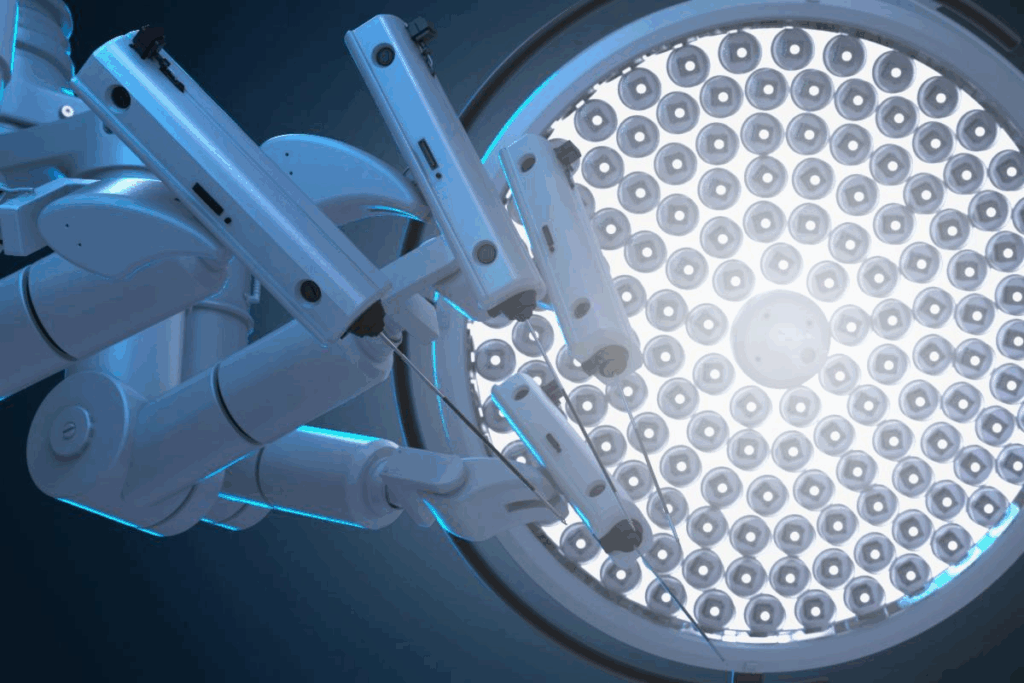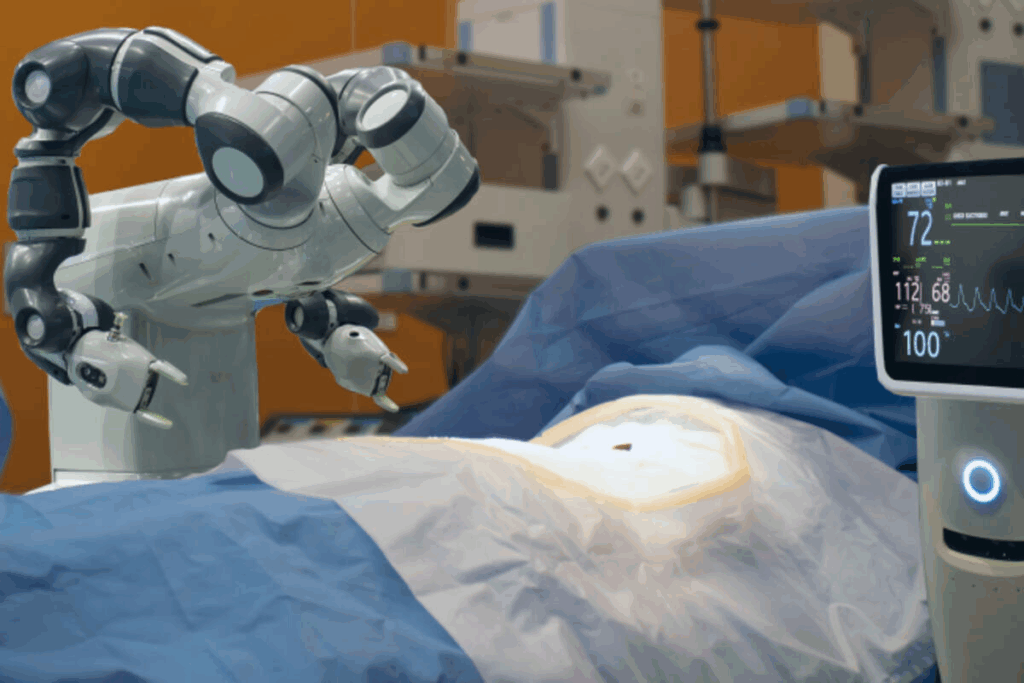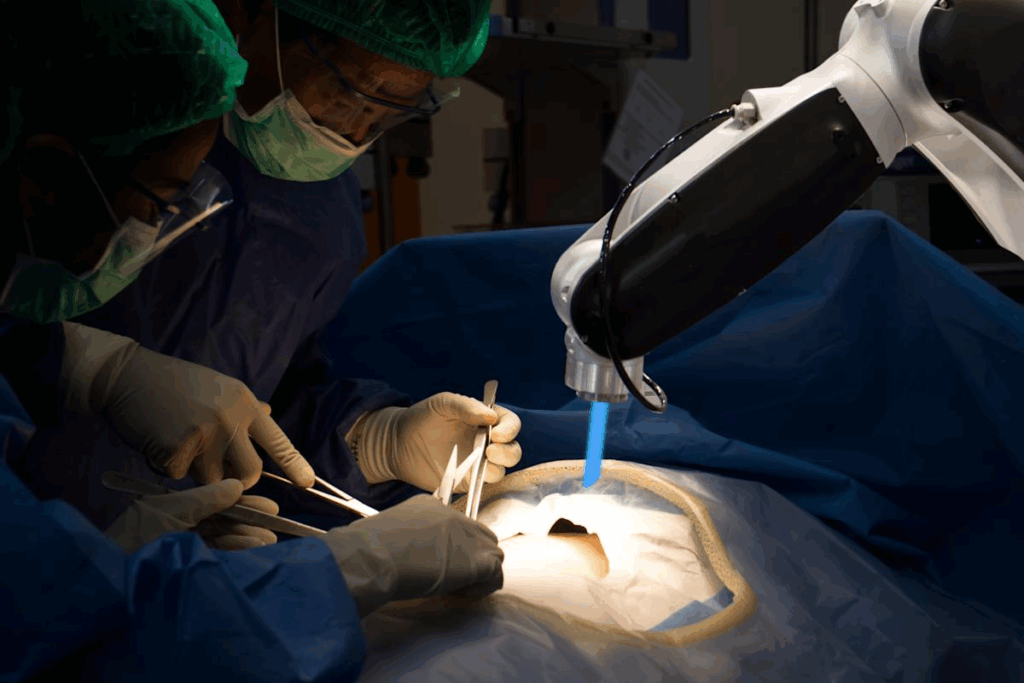Last Updated on October 30, 2025 by Bilal Hasdemir

The da Vinci Surgical System is changing how surgeries are done around the world. It sets new standards for being accurate, safe, and better for patients. This machine is made for minimally invasive procedures with better precision and control.
The da Vinci robot is a big step forward in surgery technology. It lets medical teams do many surgeries, like fixing the colon, gallbladder, and hernias, with better results.
At Liv Hospital, patients get top-notch care from a team that cares about them. They use the latest technology and are very kind.

Robotic-assisted surgery started in the 1980s, thanks to NASA and DARPA. It has grown a lot with the da Vinci system. This change has made surgery better, with more precision and less harm.
Going from old surgery to new, minimally invasive methods was a big step. Robotic surgery is the next big thing. It gives surgeons better control, precision, and views. The da Vinci system by Intuitive Surgical leads this change.
Key advancements in robotic surgery include:
The da Vinci system came out in the late 1990s. It has gotten better over time, with the Si da Vinci robot being the latest. This system lets surgeons work from a special console. They use 3D vision and feel feedback in real time for better results.
The da Vinci system has helped over 775,000 patients worldwide. It’s used in many surgeries, like urology, gynecology, and heart surgery.
| Surgical Specialty | Number of Procedures | Benefits |
| Urology | Prostatectomies, nephrectomies | Reduced recovery time, less blood loss |
| Gynecology | Hysterectomies, endometriosis treatment | Minimally invasive, less trauma to surrounding tissues |
| Cardiothoracic Surgery | CABG, mitral valve repair | Enhanced precision, reduced risk of complications |
The da Vinci system has greatly improved patient care. It has led to faster recovery, less blood loss, and better looks.

The da Vinci Surgical System is a cutting-edge robotic platform. It helps surgeons perform complex surgeries better. Its advanced technology makes surgeries more precise and minimally invasive.
This leads to faster recovery times and better patient results.
The da Vinci System has three main parts: the Surgeon’s Console, the Patient Cart, and the Vision Cart. The Surgeon’s Console lets the surgeon control the robotic arms. It uses a high-definition 3D display and precise manipulators.
The Patient Cart holds the robotic arms that do the surgery. The Vision Cart gives the needed visualization technology.
The Surgeon’s Console is designed to reduce fatigue during long surgeries. It has a high-resolution 3D display for a clear view of the surgical site. The controls allow for precise arm movement, with haptic feedback for better touch.
“The da Vinci System’s console provides an immersive experience, allowing surgeons to operate with enhanced precision and control.”
The Patient-Side Cart has robotic arms that can do complex tasks with great precision. These arms are designed to mimic human hand movements but are more flexible and stable. The surgeon controls them from the console, making precise dissection and suturing possible.
| Component | Function |
| Surgeon’s Console | Controls the robotic arms and provides 3D visualization |
| Patient Cart | Houses the robotic arms that perform the surgery |
| Vision Cart | Provides visualization technology for the surgical site |
The Vision System of the da Vinci Surgical System is key for clear images of the surgical site. It has advanced image processing, making visual information clearer and more detailed. This advanced visualization helps in precise tissue identification and dissection.
The da Vinci System’s technology, including its ergonomic console and precise robotic arms, enhances surgical performance. It improves patient outcomes. Understanding the system helps surgeons use it to the fullest, providing the best care.
The da Vinci arm is a game-changer in robotic surgery, bringing unmatched precision. It achieves this through advanced features that boost the surgeon’s skills.
The da Vinci arm allows for multi-directional movement beyond human capability. It’s controlled through a special console surgery interface. With 7 degrees of freedom, it’s more flexible than traditional laparoscopic surgery’s 4 degrees.
This flexibility means more precise movements and better access to hard-to-reach areas.
The da Vinci arm’s tremor filtration technology is a key precision booster. It removes the surgeon’s natural tremors, making the robotic arms’ movements smooth and precise. This is vital in delicate surgeries where small tremors can cause big problems.
The da Vinci system also has precision scaling of the surgeon’s movements. It takes the surgeon’s large console movements and scales them down to precise, small robotic arm movements. This scaling improves procedure accuracy, enabling more detailed work.
| Feature | Description | Benefit |
| Multi-Directional Movement | 7 degrees of freedom | Greater flexibility and precision |
| Tremor Filtration Technology | Filters out natural hand tremors | Smooth and precise movements |
| Precision Scaling | Scales down surgeon’s movements | Enhanced accuracy and detail |
In conclusion, the da Vinci arm’s precision comes from its advanced features. These include multi-directional movement, tremor filtration, and precision scaling. Together, they give surgeons the tools to do complex surgeries with confidence and accuracy.
The da Vinci Robot’s advanced visualization capabilities offer a new level of precision and clarity in surgical operations. This feature is key in helping surgeons navigate complex anatomical structures with ease.
The da Vinci System gives surgeons a highly immersive visual experience. They can operate with enhanced depth perception. This 3D high-definition visualization provides a more accurate view of the surgical site.
Surgeons can dive into the surgical environment, thanks to the high-resolution 3D imagery. This immersive experience is very helpful during complex procedures. It lets surgeons see the anatomy in detail.
The da Vinci System’s ability to magnify the surgical site is a big advantage. The magnification capabilities let surgeons see even the smallest details clearly. This is key for delicate procedures.
The system’s high-definition visualization, combined with its magnification, helps surgeons identify and preserve critical structures. This is a big step up from traditional surgical methods.
The da Vinci System’s advanced visualization also helps with real-time tissue identification. This is important for telling different types of tissue apart during surgery.
By giving surgeons real-time visual feedback, the da Vinci System improves their ability to navigate complex anatomy. This feature is very valuable in reducing complications and improving patient outcomes.
Surgeons using the da Vinci system have an intuitive console that boosts their control. The console mimics the position of eyes and hands in open surgery. This makes it easier for surgeons to coordinate and control.
The ergonomic design of the da Vinci console lets surgeons work comfortably. This reduces fatigue during long surgeries. Surgeons can stay focused and precise, even in complex cases.
The da Vinci system is known for its visual feedback. But, new real-time force feedback features are being added. These help surgeons feel the tissue, which is key for delicate procedures.
The da Vinci system’s console turns the surgeon’s hand movements into precise robotic actions. This seamless translation lets surgeons do detailed work that’s hard or impossible by hand.
The da Vinci system’s console is a big step forward in surgery. It gives surgeons the tools to do complex surgeries more easily and accurately.
The da Vinci surgical system changes surgery with its new way of doing things. It lets surgeons do complex tasks with more precision and less harm to the patient.
The da Vinci system makes smaller incisions than old-school surgery. This smaller size means less damage to tissues and fewer risks.
With the da Vinci system’s robotic arms, surgeons can work on tricky parts with less harm to nearby tissues. This care means fewer problems and quicker healing.
The da Vinci system’s skill to remove tremors and offer exact movement scaling lets surgeons be very gentle. This is something old surgery can’t do.
The da Vinci system’s arms can get into tough spots in the body. This lets surgeons do tricky surgeries that were hard or impossible before.
This is really good for urology and gynecology. These fields need very careful work.
The da Vinci system’s new way of surgery means shorter stays in the hospital, faster healing, and fewer problems. It makes surgery better for patients and raises the quality of care.
The da Vinci robotic surgery system has advanced haptic feedback. This technology improves the surgeon’s touch during complex surgeries. It’s key for precise and controlled operations.
The system’s haptic feedback gives surgeons a deeper experience. It turns touch sensations into feedback in real time. This helps surgeons understand tissue resistance and texture better.
The da Vinci system’s ability to translate touch is a big step forward in robotic surgery. It gives surgeons real-time feedback. This helps them make better decisions during surgery.
Tactile sensation translation uses advanced sensors. These sensors pick up even small changes in tissue resistance. The feedback is sent to the surgeon’s console for precise control.
Monitoring pressure and resistance is a key part of the da Vinci system’s haptic feedback. It keeps track of these during surgery. This gives surgeons important insights into tissue properties.
| Feature | Description | Benefit |
| Tactile Sensation Translation | Translates tissue resistance into real-time feedback | Improved precision and control |
| Pressure and Resistance Monitoring | Continuously monitors pressure and resistance | Enhanced situational awareness |
The da Vinci system’s haptic feedback greatly improves decision-making during surgery. It gives surgeons a full view of the surgical site. This mix of visual and touch information helps surgeons make better choices.
The da Vinci system’s controls and haptic feedback reduce fatigue and improve performance. It offers a natural and intuitive way to perform surgery. This lets surgeons focus on the task at hand, not the technology.
The da Vinci system is very versatile. It can be used in many surgical procedures. This makes it very useful for surgeons in different fields.
In urology, the da Vinci system helps with complex surgeries like prostate and kidney removals. It offers 3D views and precise tools. This helps surgeons work on delicate areas with great care.
The da Vinci system also helps in gynecology. It’s used for surgeries like hysterectomies and treatments for endometriosis. Its technology gives surgeons a clear view of the area. This leads to more accurate surgeries and fewer complications.
In cardiac surgery, the da Vinci system is used for repairs like mitral valve and coronary artery bypass grafting. For general surgery, it’s used for operations like gallbladder removal and hernia repairs. Its versatility helps in faster recovery and less scarring for patients.
The da Vinci system is also being explored for new uses in surgery. Its ability to adapt and the development of new tools and software open up more possibilities. This makes it a key player in the future of surgery.
| Surgical Specialty | Procedures | Benefits |
| Urology | Prostatectomies, Nephrectomies | Enhanced precision, Reduced complications |
| Gynecology | Hysterectomies, Endometriosis treatments | Accurate dissections, Minimal scarring |
| Cardiac Surgery | Mitral valve repair, Coronary artery bypass grafting | Reduced recovery time, Improved outcomes |
| General Surgery | Cholecystectomies, Hernia repairs | Minimally invasive, Less trauma to surrounding tissues |
The da Vinci system offers top-notch training for surgeons. These programs help surgeons learn how to use the da Vinci robotic system well.
The da Vinci system has structured training for surgeons. It includes both theory and practice. Surgeons learn a lot to master the system.
Virtual reality simulation is key in da Vinci training. It lets surgeons practice in a real-like setting. This helps them improve their skills.
Surgeons need to keep learning new techniques. The da Vinci system helps with ongoing training and education.
| Training Component | Description | Benefits |
| Theoretical Training | Covers the basics of robotic surgery | Boosts understanding of the da Vinci system |
| Practical Training | Hands-on with the da Vinci system | Builds surgical skills and confidence |
| Virtual Reality Simulation | Realistic simulation of surgeries | Improves dexterity and precision |
The da Vinci system makes sure surgeons are ready to give the best care. It offers detailed training and simulation.
The da Vinci Robotic Surgery System brings many benefits to patients. Its advanced technology and precise surgery have changed how we do operations. This leads to better results for patients.
Patients gain a lot from the da Vinci system. One big plus is faster recovery times. This is because the system uses smaller cuts and less damage to tissues. So, patients can get back to their lives sooner.
Da Vinci surgery is less invasive. This means smaller cuts and less damage. As a result, the body heals faster. Patients can get back to their normal activities quicker.
Da Vinci surgery often means reduced hospital stays. The system’s design and the smaller cuts lead to fewer complications. This lets patients go home sooner.
The da Vinci system’s precision helps lower complication rates. Its advanced tools and clear views help surgeons work more accurately. This reduces risks during and after surgery.
Da Vinci surgery also offers improved cosmetic results. The small cuts mean less scarring. This is great for patients who need surgery in areas that are easy to see.
To show the benefits of da Vinci surgery, let’s compare:
| Outcome | da Vinci Surgery | Traditional Surgery |
| Recovery Time | Faster | Longer |
| Hospital Stay | Shorter | Longer |
| Complication Rate | Lower | Higher |
| Cosmetic Results | Better | Less favorable |
The da Vinci Robotic Surgery System has been used in over 775,000 surgeries worldwide. Patients have seen faster recoveries, shorter hospital stays, and fewer complications. As the technology improves, these benefits will likely grow even more.
The da Vinci robotic surgery system has changed the face of modern surgery. It offers patients more precise and less invasive procedures. This leads to faster recovery times.
Its advanced technology and user-friendly interface make complex surgeries easier. Surgeons can now perform these operations with greater precision and less invasiveness.
The da Vinci robotic surgery has greatly impacted surgical practices. It has improved patient outcomes and opened new possibilities for surgeons. As robotic surgery evolves, the da Vinci system will continue to lead the way. It will shape the future of surgery and enhance the lives of patients globally.
The da Vinci robot, also known as the da Vinci Surgical System, is a robotic surgery system. It was developed by Intuitive Surgical. It lets surgeons do complex procedures with better precision and less invasiveness.
The da Vinci Surgical System has a surgeon’s console, a patient-side cart, and a vision system. Together, they make it possible to do precise and minimally invasive surgeries.
Using the da Vinci robot has many benefits. It offers better precision, smaller cuts, and less damage to tissues. It also leads to faster recovery times and fewer complications for patients.
The da Vinci arm has several key features. It can move in many directions, filters out tremors, and scales the surgeon’s movements. These features help surgeons do complex procedures with more precision.
The da Vinci system offers advanced 3D high-definition visualization. It gives surgeons an immersive visual experience, magnifies images, and identifies tissues in real-time. This enhances their ability to perform complex procedures.
The intuitive console surgery interface is designed ergonomically. It provides real-time force feedback and translates hand movements seamlessly. This design enhances the surgeon’s control and precision during surgery.
Yes, the da Vinci system is versatile. It can be used in various surgical specialties like urology, gynecology, cardiac, and general surgery. It also has expanding applications in new surgical domains.
The da Vinci system offers advanced training and simulation capabilities. It includes surgeon training programs, virtual reality simulation, and continuous skill development. This ensures surgeons are proficient in using the system.
Da Vinci robotic surgery offers several benefits for patients. It leads to faster recovery times, shorter hospital stays, lower complication rates, and better cosmetic results. These benefits contribute to improved patient outcomes and satisfaction.
Yes, the da Vinci system is widely used globally. Over 775,000 patients have been treated with it. It has revolutionized surgical practices by enabling minimally invasive procedures with improved outcomes.
Intuitive Surgical. (2020). The da Vinci surgical system: Overview and clinical applications. Journal of Robotic Surgery, 14(1), 1-14. https://www.ncbi.nlm.nih.gov/pmc/articles/PMC6981827/
Subscribe to our e-newsletter to stay informed about the latest innovations in the world of health and exclusive offers!
WhatsApp us